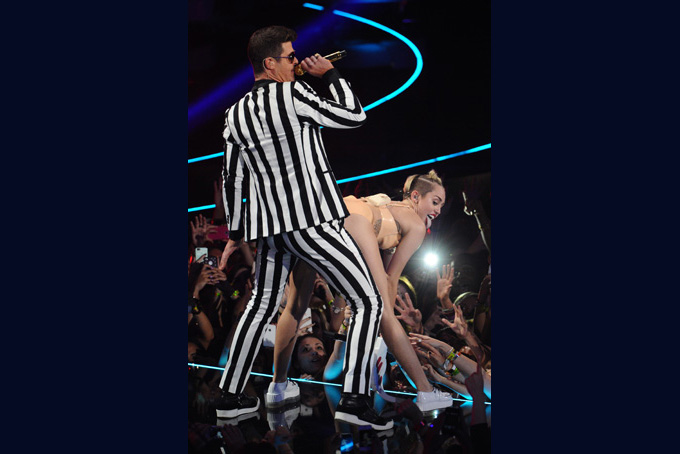
Robin Thicke and Miley Cyrus perform “Blurred Lines” at the MTV Video Music Awards on Sunday, Aug. 25, 2013, at the Barclays Center in the Brooklyn borough of New York. (Photo by Charles Sykes/Invision/AP)
by Jonathan Anker
(CNN) — Google has some great news for Miley Cyrus.
If her provocative performance at Sunday night’s VMAs is any indicator, the pop star seems to want nothing more in the entire world than to disassociate herself from her Disney past. Well, the search engine reveals that she may have gotten her wish.
She’s making major progress in attaching her name to something other than “Hannah Montana.”
If you type “Miley Cyrus” into Google, the second autofilled suggested search result is “Miley Cyrus twerk.” The only suggested result ranking higher? “Miley Cyrus We Can’t Stop,” the video in which she twerks.
“Hannah Montana” is nowhere to be found.
So there you have it, kids (and grown-ups?): If you want to fabricate some street cred and impress on the dance floor in 2013, you better get to twerking.
The booty-bounce-heavy dance move is not new, not at all. It’s just finally having its moment. And somehow, little once-squeaky-clean Cyrus has played a major role in that.
Depending on whom you ask, twerking began either in the 2 Live Crew-dominated Miami Bass scene in the late 1980s or a few years after that in the New Orleans bounce scene, where the term emerged.
And while even Urban Dictionary is at a complete loss for a single, accepted definition, twerking — if we may be frank — is basically shaking your tush. Jiggling it. Popping it. Furiously. Rhythmically. Sometimes while bent over. Sometimes while crouching. And always with a big assist from your hips.
There are a bunch of advanced moves, including the famed Wall Twerk, which is a nice way to liven up any cocktail party with co-workers*. It’s also the move that landed 33 San Diego high school students five-day suspensions for violating the school’s sexual harassment policy.
*Please don’t actually do this. You will probably get fired.
So twerking is sort of like this generation’s forbidden dance. Yes, it’s the Lambada for millennials. (“The Lam-what?” — Your children)
It began its mainstream assault in 2006, when Beyonce included the lyric “dip it, pop it, twerk it, stop it” in her song “Check On It,” which appeared on the “Pink Panther” soundtrack, of all the unexpected places for this massively sexualized dance trend to launch.
A barrage of YouTube videos soon followed, led by a group of Atlanta girls called the Twerk Team, who racked up views by the millions for their impossibly rapid-fire and impressively athletic twerking. And on it went for the next few years, taking over dance floors, school hallways, hip-hop in general and the imaginations of teenage boys.
By the time Cyrus dressed up in a unicorn costume and unleashed her twerking on an unsuspecting America, the machine was already in place. It just needed someone to twerk it — and she quickly became the mainstream face of twerking.
There she is busting it out on stage at a Juicy J concert!
There she goes twerking all over the place in her hit video for “We Can’t Stop”!
There’s Jay-Z rhyming about her twerking on his new album!
And of course, there she was twerking it all over Robin Thicke at the VMAs.
So of course you know what all this mainstream, overexposed, pop star-approved twerking means right?
Guys, twerking is over.